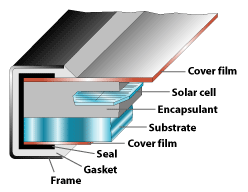|
How Do Solar Panels Work? A Basic Understanding Of Solar Technology.In answering the question how do solar panels work, you’ll learn what solar pannels are made of, how they generate electricity and the types of solar technology available today.
A solar panel also known as a module is made up of solar cells. These cells convert sunlight into electricity, which can then be used to provide power for your electrical needs.

This process is called the photovoltaic (pv) effect. Photo is derived from the greek word meaning light and volt relates to the electricity pioneer Allesandro Volta. So the word photovoltaics means electricity from light. How does Light Convert To Electricity?
Ok, we want to keep this site as simplistic as possible in educating you on the understanding of this technology. However, we occasionally have to get a bit scientific in describing how it works. So, we go… How do solar panels work? Sunlight consists of little particles of solar energy called photons. Solar pannels are made up of several individual solar cells which are made of at least 2 layers of semiconductor materials. One layer containing a positive charge and the other a negative charge. These materials are layers of silicon, phosphorus (which provides the negative charge), and boron (which provides the positive charge).
As a pv cell is exposed to the sunlight, many of the photons are either reflected, pass right through or absorbed by the solar cell. When enough photons are absorbed by the negative layer,(phosphorus), electrons are freed from the negative semiconductor material. These freed electrons naturally migrate to the positive layer (boron) creating an electric field at the surface where they meet, similar to a household battery. The electrical field causes the electrons to move toward the negative surface where they become available to the electrical circuit. When the two layers are connected to an external load, the electrons flow through the circuit creating electricity. A solar cell will typically produce between 1-2 watts of power each. In order to gain more power, these cells are connected together to make a solar panel (module) that will typically hold about 40 cells.
Most solar energy panels have an aluminum frame around the outside with tempered glass on the front that encloses the cells with a sealed waterproof back. These solar pannels (modules) can then be connected together to form an array which will then generate more power. So the building of a solar system to generate electricity starts with the basic building block of the solar cell that generates the electricity. The cells are joined together to form a solar panel, and the solar energy panels are connected to form a solar array. 
If this array of solar energy panels is large enough, it can meet nearly any electricity demand you will ever need. Solar Efficiency A solar cells efficiency is measured by how well it converts sunlight to electricity. As we just talked about, when light shines on a pv cell it is either reflected, absorbed or it will pass right through. Only absorbed light generates electricity. So only a small portion of the sunlight reaching the cell, about 15%, actually generates electricity. This can be one drawback, in that it takes more solar pannels to generate a large amount of electricity with a higher cost. However, there are great strides being made everyday and many of the many benefits far outweigh the negatives with regard to the use of solar energy panels. DC and AC Electricity Solar cells generate direct current (dc) electricity. So when using a solar array to generate electricity for a home, an inverter will be used to convert the dc electricity in ac (alternating current) electricity, which is what is typically used for all of your appliances and outlets in your home. Moving on, here are more answers to how do solar panels work? Solar Technologies
There are 4 different types of technologies used in solar energy panels;
 This technology does however have benefits when used in flexible solar panels, thin film roofing tiles or thin film solar panels.
This technology does however have benefits when used in flexible solar panels, thin film roofing tiles or thin film solar panels.
There you have it. The science of solar energy panels in a nutshell. We hope this helps to answer the question, how do solar panels work, and gives you a greater enlightenment on solar technology. Want To Save Up To 35% On Your Power Bills? Click Here! Return from how do solar panels work to solar power panels.
|






